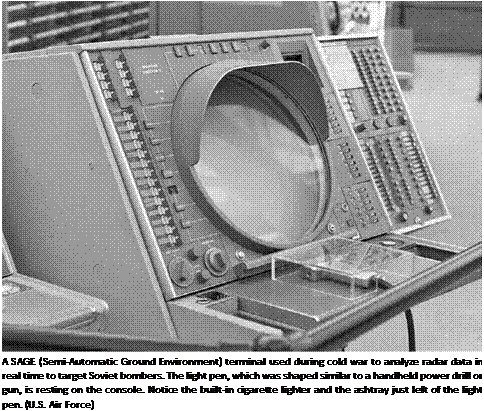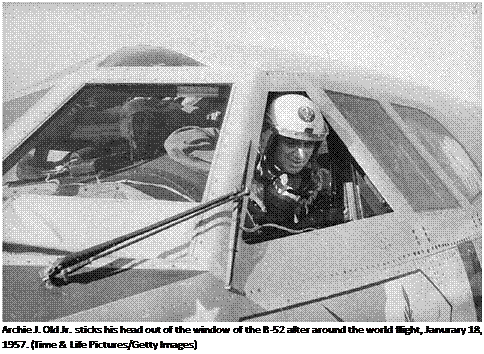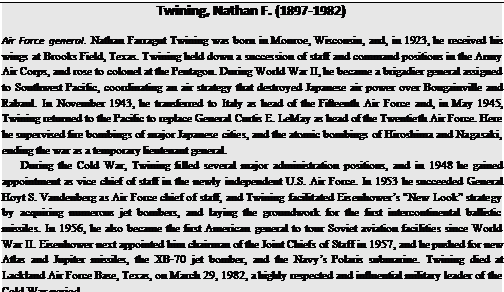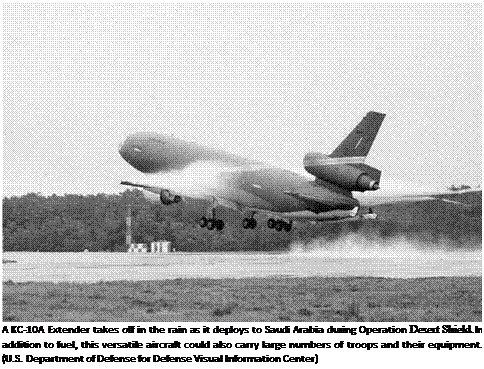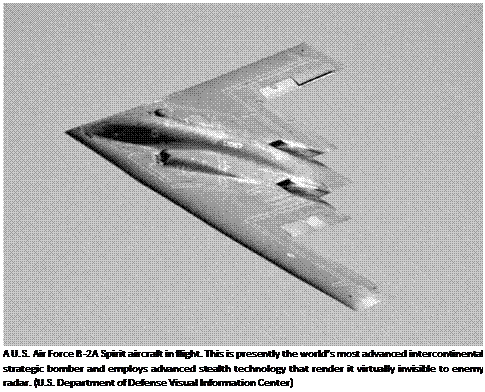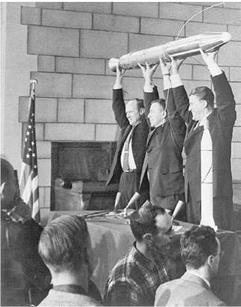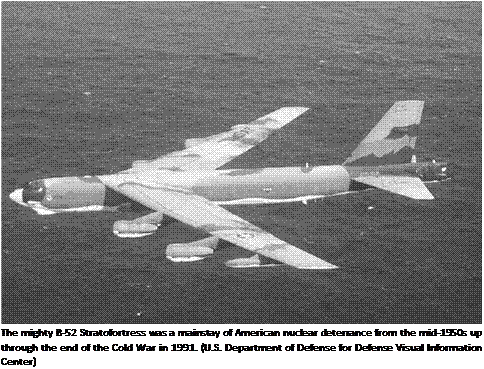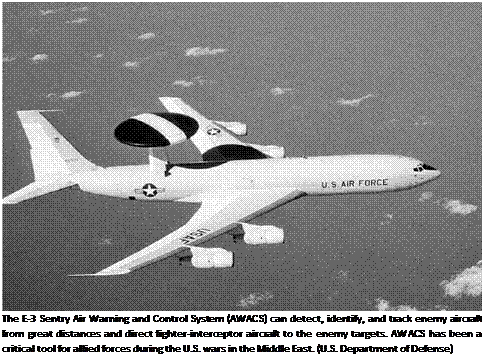JANUARY 3 In Panama, captured dictator
Manuel Noriega is packed onto an Air Force C-130 and extradited back to the United States to face drug trafficking charges in Miami, Florida.
JANUARY 31 Operation coronet cove, a decade-old maneuver that rotated Air National Guard units into the Panama Canal Zone, terminates after 13,000 sorties.
FEBRUARY In Monrovia, Liberia, aircraft from the 436th Military Airlift Wing and the 463rd Tactical Airlift Wing arrive with 30 tons of relief supplies for refugees fleeing a civil war.
February—MARCH In Western and American Samoa, transports of the 60th and 63rd Military Airlift Wing deliver 410 tons of relief supplies in the wake of Typhoon Ofa.
FEBRUARY 23 In Senegal, aircraft of the 435th Tactical Airlift Wing convey 11 tons of food, medical supplies, and 60 medics to combat an epidemic.
FEBRUARY 26 The Air Force retires the legendary Lockheed SR-71 Blackbird from active service owing to extreme operating costs, and improvements in satellite photography.
MARCH 6 In Washington, D. C., a Lockheed SR-71 Blackbird touches down after setting four transcontinental airspeed records, including 2,124 miles per hour on a transcontinental crossing. Once parked, it is handed over to the National Air and Space Museum, Smithsonian Institution for permanent display.
April 11 In Europe, the first Pershing II missiles destined to be destroyed under provisions of the recent INF Treaty between the united States and Soviet union are loaded onto a C-5 Galaxy.
April 21 At Nellis Air Force Base, Nevada, the Lockheed F-117 Nighthawk
is publicly displayed for the first time; it is beheld by an estimated 100,000 visitors.
May 4 The AIM-120A advanced medium- range air-to-air missile (AMRAAM) is approved by the Air Force for use on fighter craft.
May 22 The Twenty-Third Air Force gives rise to the Special Operations Command (SOC).
July 1 In Washington, D. C., General Michael J. Dugan becomes chief of staff, U. S. Air Force.
July 12 The final production F-117 Nighthawk is delivered by Lockheed to the Air Force; 59 are acquired in all.
July 17 Baguio, Philippines, is destroyed by a severe earthquake and the Air Force flies in 600 tons of relief equipment to
|
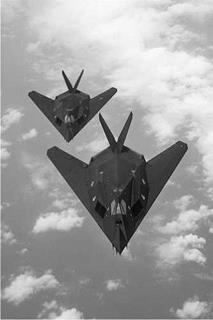
Two-ship formation of Lockheed F-117A Night – hawk Stealth fighter aircraft. This was the world’s first military aircraft to boast afunctional “invisibility” to enemy radar. (U. S. Department of Defense)
|
look for survivors; 2,475 passengers are also flown to medical facilities for treatment.
July 24 The EC-135 Looking Glass aircraft, intended to control and coordinate nuclear command posts in the event of a nuclear war, finally stands down. It flew continuously during three decades of service and hundreds of thousands of flying hours, yet never experienced a single accident.
August-September The Air Force Space Command (AFSPACECOM) initiates the first space system infrastructure capable of directly supporting a military conflict. It is capable of relaying communications, navigation and meteorological information, along with detecting short-range ballistic missile launches.
August 7 At Langley Air Force Base, Virginia, the 71st Tactical Fighter Squadron (TFS), 1st Tactical Fighter Wing, dispatches 24 F-15C Eagles on the 8,000- mile flight to Dhahran, Saudi Arabia. The flight concludes 15 hours later with the help of 12 in-flight refuelings.
August 8 At Dhahran, Saudi Arabia, an Air Force Reserve C-141 Starlifter lands, becoming the first American aircraft deployed in this theater. They are soon joined by F-15Cs from the 1st Tactical Fighter Wing. Additional AWACS aircraft also arrive to assist Saudi AWACS already orbiting the kingdom.
Air Force Vice Chief of Staff Lieutenant General Mike Loh orders the Air Staff planning group (Checkmate) under Colonel John Warden to initiate plans for conducting a strategic air war against Iraqi forces. This comes in response to a request from General H. Norman Schwarzkopf, the coalition commander.
AUGUST 9 The old Alaskan Air Command is designated the Eleventh Air Force, and it is assigned to the Pacific Air Forces (PACAF).
AUGUST 10 At Central Command (CENTCOM), MacDill Air Force Base, Florida, Colonel John Warren proffers a preliminary draft for air operations in the Persian Gulf to General H. Norman Schwarzkopf. General Charles Horner also draws up contingency plans in the event that Iraqi forces attack Saudi Arabia before the Americans deploy in force.
Detachments of F-16s and C-130s from Pope Air Force Base, North Carolina, begin filtering into Saudi Arabia.
AUGUST 12 At Dhahran, Saudi Arabia, the first 32 KC-135 tanker aircraft deploy, being the first of over 300 KC – 135s and KC-10s scheduled there. These are joined by MH-53J Pave Low helicopters of the 1st Special Operations Wing.
AUGUST 14 In Washington, D. C., the presence of E-3 AWACS, KC-10s, KC – 135s, and RC-135s in the Persian Gulf theater is announced by the Department ofDefense.
AUGUST 15 At Tonopah, Nevada, top secret F-117 stealth aircraft of the 37th Tactical Fighter Wing (TFW) deploy to Saudi Arabia; they are soon joined by F – 4G Wild Weasels flying in from George Air Force Base, California.
AUGUST 16 At Myrtle Beach Air Force Base, South Carolina, A-10 Thunderbolt IIs depart en masse for deployment to Saudi Arabia.
AUGUST 17 In Washington, D. C., the Civil Reserve Air Fleet is mobilized by President George H. W. Bush for the first time since 1952. Their aircraft are impressed as troop carriers to accelerate the Persian Gulf buildup.
General H. Norman Schwarzkopf approves the air campaign strategy, so Colonel John Warden is dispatched to Saudi Arabia to brief General Charles Horner as to its details.
The Air Force Space Command establishes the Defense Satellite Communications Systems (DSCS) to facilitate command links to Operation desert
SHIELD.
AUGUST 19 At Mushait Air Base, Saudi Arabia, 18 F-117 Nighthawks from the 415th Tactical Fighter Squadron arrive for service during Operation desert shield.
AUGUST 20 In Saudi Arabia, General Charles Horner declares that Saudi Arabia can now be defended against any Iraqi attack with the air power presently in the Gulf region. He is also briefed by Colonel John Warden as to the forthcoming campaign for waging a strategic air war.
AUGUST 21 In the Persian Gulf, the Air Force has deployed A-10s, C-130s, E-3 AWACS, F-4Gs, F-15s, F-15Es, F-16s, F-117s, KC-135, KC-10s, and RC – 135s, being the largest concentration of military aircraft outside the United States since Vietnam.
The Air Force requests 6,000 reservists to join up and no less than 15,000 volunteer for service in Operation desert
SHIELD.
AUGUST 22 Air Force Reserve personnel have flown 8,000 soldiers and 7 million tons of military cargo to Saudi Arabia for service in Operation desert storm; 20,000 reservists and 12,000 Air National Guardsmen are also slated for service in the Persian Gulf.
AUGUST 23 At Andrews Air Force Base, Maryland, the 89th Military Airlift Wing deploys the first of two VC-25As (highly modified Boeing 747s). Whenever a president is on board, the aircraft receives the call sign Air Force One.
In Washington, D. C., Secretary of Defense Dick Cheney authorizes the Air Force reserve components to mobilize for service in the Persian Gulf; 20,000 are called to the colors.
AUGUST 24 At Birmingham, Alabama, six of its RF-4C Phantom IIs from the 117th Tactical Reconnaissance Wing are dispatched to the Persian Gulf region. They are soon joined by similar aircraft sent by the 67th Tactical Reconnaissance Wing, Bergstrom Air Force Base, Texas.
AUGUST 28 At Torrejon, Spain, F-16 fighters fly off on a new deployment to airfields in Qatar.
AUGUST 29 At Ramstein Air Base, West Germany, a C-5 Galaxy crashes on
takeoff, killing 13 people. Staff Sergeant Lorenzo Galvin, Jr., wins the Airman’s Medal for heroically assisting crash victims.
September 5 In Saudi Arabia, five C-130 units from the Air National Guard (ANG) deploy for active duty.
September 6 The U. S. Post Office issues a 40-cent stamp with a portrait of Lieutenant General Claire L. Chennault, who commanded the famous “Flying Tigers” of World War II.
SEPTEMBER 8 Colonel Marcelite Jordan Harris is the first African American woman promoted to brigadier general in the U. S. Air Force. She also gains appointment as director ofAir Training Command’s technical training.
In Saudi Arabia, the first wave ofAC – 130H gunships from the 16th Special Operations Squadron deploys for active duty.
SEPTEMBER 13 In Riyadh, Saudi Arabia, Air Force Brigadier General Buster
Glosson, deputy commander, Joint Task Force Middle East, briefs Generals H. Norman Schwarzkopf and Colin Powell on the final operational air war plan subsequent to Operation DESERT SHIELD.
SEPTEMBER 17 In Washington, D. C., Air Force Chief of Staff Michael J. Dugan is relieved by Secretary of Defense Dick Cheney for unauthorized comments made to the media about Operation DESERT SHIELD.
September 18—28 In Jordan, transports of the 436th and 438th Miliary Airlift Wings deliver tons ofblankets, tents, cots, and other impedimenta for the 100,000 foreign workers fleeing from Kuwait.
September 29 The new Lockheed/ General Dynamics YF-22A Raptor air superiority/stealth fighter prototype is ferried to Edwards Air Force Base, California, for testing.
OCTOBER 1 Control of Patrick Air Force Base, Florida, passes from the Air Force Systems Command to the Air Force Space Command.
OCTOBER 10 Throughout the Persian Gulf, Air Force fighter and fighter – bomber units begin exercises to familiarize them with desert warfare while F-15Cs begin performing combat air patrols (CAP).
OCTOBER 30 In Washington, D. C., General Merrill A. McPeak is appointed the new Air Force chiefofstaff.
Operation DESERT EXPRESS commences as Air Force transports expedite shipment ofcertain critical items to the Persian Gulf.
NOVEMBER 3 Over Edwards Air Force Base, California, the prototype YF-22A Advanced Technology Fighter (ATF) becomes the first jet aircraft to achieve supersonic speed through a process known as “supercruise.” This does not require the use of afterburners.
NOVEMBER 17 Above the Indian Ocean a DSCS II satellite is placed by the Air Force Space Command to enhance DESERT SHIELD communications.
NOVEMBER 21 From Davis-Monthan
Air Force Base, Arizona, additional A-10 Thunderbolt IIs deploy directly to Saudi Arabia.
December 1—2 Off the Korean coast, 22 shipwrecked sailors from a grounded Panamanian vessel are rescued by two MH-60 Pave Hawk helicopters of the 38th Air Rescue Squadron.
December 5 In Saudi Arabia, RF-4C Phantom IIs of the 152nd Tactical Reconnaissance Group begin arriving in theater.
December 29 In the Persian Gulf, the 169th Tactical Fighter Group becomes the first Air National Guard (ANG) unit deployed for active duty in Operation
DESERT SHIELD.
JANUARY 2 In Saudi Arabia, the 4th Tactical Fighter Wing (Provisional) is cobbled together from Air National
Guard F-16s of the 174th Tactical Fighter Wing and the 169th Tactical Fighter Group.
JANUARY 11 At Riyadh, Saudi Arabia,
the two pre-production E-8AJSTARS aircraft deploy for use against Iraq; this highly advanced reconnaissance platform is capable of providing real-time surveillance over battlefields.
JANUARY 15 Command of Vandenberg Air Force Base, California, passes from the Strategic Air Command (SAC) to the Air Force Space Command.
JANUARY 16 Operation desert storm commences as seven B-52Gs of the 2nd Bomb Wing launch from Barksdale Air Force Base, Louisiana, armed with new AGM-86C conventional air-launched cruise missiles (ALCMs). This is also history’s longest bombing mission and requires 35 hours of flight time.
JANUARY 17 Over Kuwait, American
and coalition aircraft begin attacking Iraqi military targets, missile sites, and communications facilities deemed useful to Saddam Hussein’s occupying forces. They mount 750 attack sorties while carrier aircraft contribute a further 228. The aerial campaign continues without interruption for 38 days.
Among the first wave of aircraft to go in are AH-64A Apache helicopter gun – ships, guided by Air Force MH-53 Special Operations helicopters.
Seven B-52Gs from Barksdale Air Force Base, Louisiana, arrive over the Persian Gulf and unleash 35 superaccurate cruise missiles against communications and radar targets in Iraq.
Over Baghdad, Iraq, stealthy F-117 Nighthawks steal past Iraqi radar defenses and bomb strategic targets throughout the city as intense antiaircraft fire continuously lights up the darkness; they account for 31 percent of all targets struck on the first day.
Over Kuwait, Air Force C-130 transports deliver 14,000 troops and 9,000 tons of cargo belonging to the Army’s XVIII Airborne Corps. This forward deployment suddenly places them on the Iraqi right flank.
An F-16C piloted by Captain Jon K. Kelk, 3rd Tactical Fighter Wing (TFW) downs the first Iraqi MiG-29 jet fighter.
January 17-February 28 C-130
transports of the 1650th Tactical Airlift Wing complete 3,200 combat sorties, while A-10 Thunderbolt IIs from the 706th Tactical Fighter Squadron fly
I, 000 sorties against enemy targets. No Air Force Reserve aircraft are lost in combat despite this operational intensity.
JANUARY 18 Over Iraq, U. S. and coalition aircraft down eight Iraqi MiG-29 and Mirage F-1 fighters.
From Incirlik Air Base, Turkey, Air Force jets strike at military targets in northern Iraq to prevent them from concentrating against forces moving up from Saudi Arabia.
JANUARY 19 Over Iraq, two F-16Cs of the 614th Tactical Fighter Squadron are downed by missiles and the pilots are captured and paraded before television, along with six other coalition airmen.
JANUARY 21 Over Iraq, Captain Paul T.
Johnson, piloting an A-10 Thunderbolt
II, braves antiaircraft fire to destroy Iraqi vehicles threatening a downed Navy F – 14 pilot; Johnson wins the Air Force Cross. Concurrently, an MH-53J Pave Low helicopter under Captain Thomas J. Trask, 20th Special Operations Squadron, successfully extracts the pilot; Trask wins the Mackay Trophy.
JANUARY 22 Over Iraq, an F-15E piloted by Colonel David W. Eberly and Lieutenant Colonel Tom Griffith is downed
in combat; the two evade capture over the next three days, but are captured near the Syrian border.
January 22—27 At Al Asad Air Base, Iraq, MiG aircraft in hardened aircraft shelters are destroyed by F-111Fs using laser-guided “smart” bombs.
January 23 In Washington, D. C., General Colin Powell, chairman of the Joint Chiefs of Staff, declares that air superiority has been achieved over Iraq, as enemy positions are bombed with virtual impunity.
January 24 Over the Persian Gulf, a Saudi F-15C shoots downs two Iraqi Mirage F-1 fighters carrying Exocet antiship missiles. Also, this day coalition air forces mount 2,570 sorties; the total number over the past eight days is 14,750.
JANUARY 25 Over Iraq, Air Force fighter-bombers employ new I-2000
bombs against hardened aircraft shelters, destroying several MiG-29s sequestered inside.
January 26 Coalition forces begin concentrating their attacks on enemy ground forces in Kuwait as the Iraqi Air Force is effectively neutralized.
January 27 Over Kuwait, F-111s strike oil-pumping manifolds at the main terminal at Al Ahmadi with guided GBU-15 bombs to halt the flow of crude oil into the Persian Gulf. This is also the worst deliberate oil spill ever.
January 29 Over Al Khafji, Saudi Arabia, an AC-130H gunship is downed by a missile and all 14 crew members are killed.
FEBRUARY 2 Over the Indian Ocean, a B-52 bomber returning to its base on Diego Garcia experiences electrical problems while returning from a mission over
Iraq and crashes; three crew men are rescued, but three are killed.
FEBRUARY 6 Over Iraq, Captain Robert R. Swain, Jr., flying an A-10 Thunderbolt II, shoots down an Gazelle helicopter with his 30mm cannon; this is the only aerial victory attributed to a “Warthog.”
February 9 Over Kuwait, A-10 Thunderbolt IIs begin the process of destroying individual targets with precision-guided munitions. To date, 600 enemy tanks and armored vehicles have been destroyed, roughly 15 percent of Saddam Hussein’s military strength.
February 11 Today coalition air forces mount 2,900 strike sorties for a grand total of 61,862 over a 26-day period.
FEBRUARY 12 Over Baghdad, Iraq, Air Force fighter-bombers employ “smart bombs” against the Martyr’s Bridge, the Republic Bridge, and the July 14 Bridge, destroying all three.
February 13 Acting upon a tip from military intelligence, F-117s bomb the Al Firdos bunker in downtown Baghdad, Iraq, suspected of housing Saddam Hussein. The building, a civilian communications center, is flattened with the loss of several hundred dead, but the elusive dictator was not there. Thereafter, coalition air authorities more closely supervise combat strikes in the capital city.
FEBRUARY 14 Over Saudi Arabia, an EF-111A “Spark Vark” crashes after a bombing mission over Iraq; the two – man crew ejects in their cockpit capsule, but apparently dies upon landing.
FEBRUARY 17 Coalition aircraft have since accounted for 1,300 of Saddam
Hussein’s 4,240 tanks and 1,100 of his 3,110 artillery pieces.
February 19 A combination of F-4Gs and F-16s launched from Turkish airspace attacks Baghdad, Iraq. Coalition forces also mount a record 3,000 sorties this day, for a grand total of 83,000.
FEBRUARY 21 At Freetown, Sierra Leone, a C-141 Starlifter of the 438th Military Airlift Wing arrives with 55 tons of food and medicine for victims of hardship.
FEBRUARY 23 Over Iraq, Air Force B – 52Gs pound Iraqi Republican Guard positions as retreating Iraqi troops set Kuwaiti oil wells on fire.
FEBRUARY 24 Coalition aircraft perform
3,0 combat sorties, including reconnaissance, close air support, and interdiction, over the next three days.
FEBRUARY 25 Air Force F-16Cs bomb Iraqi forces preparing to attack a Army Special Force team, while a UH-60 Black Hawk helicopter swoops in to rescue them.
FEBRUARY 27 Over Iraq, the Air Force unloads two 4,700-pound GPU-28 bombs that demolish the so-called “impregnable” command bunker at Al Taji. Total air sorties mounted this day also top 3,500—a new record.
FEBRUARY 28 Operation desert storm ceases at 8 A. M., and the Air Force has performed 59 percent of all coalition sorties. Moreover, its 2,000 aircraft represent 75 percent of all machines involved. The elusive F-117s, however, account for 40 percent of all Iraqi strategic targets knocked out in 1,270 combat sorties that delivered 2,041 tons of bombs.
desert storm is also the first “space war” judging from the extensive use ofsatellite
technology involved. The Air Force Space Command (AFSPACECOM) satellite systems were extremely active relaying meteorological information to combat headquarters, along with alerts of short – range ballistic missile launches.
MARCH 1 At Bucharest, Romania, C-5 Galaxies from the Military Airlift Command (MAC) arrive with 150 tons of relief supplies at a time of violent street confrontations and food shortages.
MARCH 8 At Vandenberg Air Force Base, California, the Martin Marietta two-stage Titan IV heavy-lift booster successfully launches for the first time.
March 8-December In the Persian Gulf region, the Military Airlift Command (MAC) demonstrates its strategic flexibility by flying an influx of supplies, personnel, and environmental cleanup equipment. Forty-two C-5 Galaxies and three C-141 Starlifters of the 60th and 436th Military Airlift Wings also transport over 1,000 tons of firefighting equipment and crews necessary to extinguish 517 oil wells set alight by retreating Iraqi forces. This done, they next provide
7,0 tons of supplies to Kurdish refugees in southeastern Turkey.
MARCH 20 Over Iraq, an F-16C downs an Iraqi Su-22 caught violating the cease-fire agreement.
April In Lima, Peru, two C-5 Galaxies of the 436th Military Airlift Wing convey 200 tons of medical supplies to stave off a cholera epidemic threatening 150,000 people.
APRIL 7 In northern Iraq, Operation provide comfort commences as Air Force warplanes assist the Kurds by enforcing a no-fly zone above the 36th parallel.
April 12 Off the Alaskan coast, a Soviet AN-74 Coaler transport aircraft is intercepted by forward-deployed F-15 Eagles stationed at Galena Airport for the first time.
April 18 At Vandenberg Air Force Base, California, a Martin Marietta/Boeing MGM-134A intercontinental ballistic missile is launched for the first time. It travels 4,000 miles downrange to the Kwajalein Missile Range.
May 10-June 13 Transports of the Military Airlift Command (MAC) begin Operation sea angel by carrying
3.0 tons of relief supplies to the city of Dacca, Bangladesh, after a tropical cyclone batters the coast with 150-mile – per-hour winds.
May 31 At RAF Greenham Common, England, the 501st Tactical Missile Wing is inactivated, being the final unit entirely armed with cruise missiles; this was also the first GLCM unit deployed in Europe.
JUNE-SEPTEMBER The Military Airlift Command (MAC) transports fly 19 humanitarian missions to Addis Ababa, Ethiopia, to mitigate severe drought conditions.
June 8—July 2 In the Philippines, once Clark Air Base is nearly destroyed by the eruption of nearby Mount Pinatubo, Operation fiery vigil unfolds to evacuate
15.0 people from the disaster zone, while bringing in 2,000 tons of relief supplies. This is also the largest emergency evacuation since the fall of South Vietnam, 1975.
June 25 In Nairobi, Kenya, transports of
the 60th Military Airlift Wing fly in 60 tons of food and other supplies to help alleviate drought conditions.
July 7 In N’Djamena, Chad, drought conditions, exacerbated by civil war, result
in 70 tons of food delivered by transports of the 436th Military Airlift Wing.
July 10 At Plattsburgh Air Force Base, New York, the final FB-111A nuclear strike aircraft is flown to its final desert storage at Davis-Monthan AFB, Arizona.
July 22 At Ulan Bator, Mongolia, transports of the 730th Military Airlift Squadron and 445th Military Airlift Wing carry 20 tons of medical supplies to help alleviate acute shortages.
July 31 In Washington, D. C., an ame
ndment allowing women to fly combat missions in Air Force, Navy, and Marine warplanes is passed by Congress.
AUGUST 6—9 In Shanghai, China, transports of the Military Airlift Command carry 75 tons ofblankets and medical supplies after severe flooding throughout the interior region.
AUGUST 22 The Air Force initiates the Gulf War Air Power Survey (GWAPS) to correctly evaluate the overall impact of air power during recent hostilities.
SEPTEMBER 15 At Long Beach, California, the new Boeing C-17A Globemaster III flies for the first time by relocating to Edwards Air Force Base. This aircraft will replace C-141s and C-5s in use. It can transport oversized cargo loads of C-5 Galaxies to remote and primitive landing zones used by C-130 Hercules.
At Edwards Air Force Base, California, the prototype Beech T-1AJayhawk flies for the first time; it becomes a standardized trainer for tanker and transport pilots.
September 27 In Washington, D. C., President George H. W. Bush orders the long-standing Strategic Air Command (SAC) alert discontinued. This has been a standard American military fixture since October 1957.
OCTOBER-NOVEMBER Air Force transports deliver food and medical supplies to the needy in Russia, Armenia, and Byelorussia, as the former Soviet Union begins unraveling.
Angola, having concluded a bloody, 16-year civil war, accepts aid from the United States as transports from the 436th Military Airlift Wing accordingly convey 275 tons of supplies to the capital of Luanda.
OCTOBER 2 At Ulan Bator, Mongolia, transports of the 834th Airlift Division fly in 15 additional pallets of medical supplies, along with 8 ambulances, to thwart endemic shortages caused by the Soviet Union’s collapse.
October 23 In Kiev, Ukraine, Air Force transports deliver 146 tons of medical and relief supplies after its economy collapses with the Soviet Union’s fall.
NOVEMBER In Pakistan, transports of the Military Airlift Command (MAC) perform their 100th humanitarian flight by assisting Afghan refugees. Since March 1986, they have also delivered over 1,000 tons of aid to the region.
NOVEMBER 1 At Thule, Greenland, a C – 5 Galaxy from the Twenty-Second Air Force flies with a 36-member search and rescue team and two MH-60G Pave
Hawks to rescue 13 crew members of a Canadian C-130 Hercules that crashed near the North Pole.
NOVEMBER 14 In Freetown, Sierra Leone, the 436th Military Airlift Wing dispatches a C-5 Galaxy with 50 tons of medical and relief supplies to mitigate food shortages.
NOVEMBER 26 In the Philippines, the Air Force closes Clark Air Base, ending a 90-year American military presence there; this was also the largest overseas Air Force base.
DECEMBER 6 The 834th Airlift Division dispatches six C-130s to Kwajalein Atoll with relief supplies after Typhoon Zelda batters its facilities.
December 17-22 In Russia, transports of the 436th, 438th, and 439th Airlift Wings deliver 238 tons of food and relief supplies to Moscow and Saint Petersburg; along with Minsk, Byelorussia; and Yerevan, Armenia. Severe economic hardships continue in the months following the Soviet Union’s collapse.
DECEMBER 21 The prototype Rockwell AC-130U gunship flies for the first time. This new variant possesses updated sensors, increased firepower, and enhanced ability to locate ground targets.
